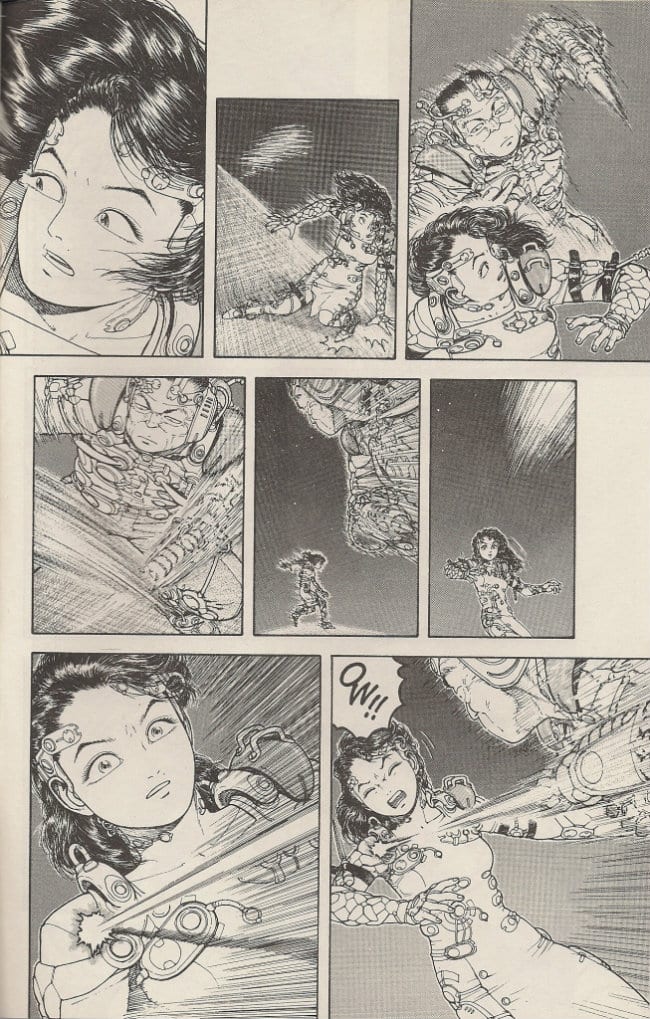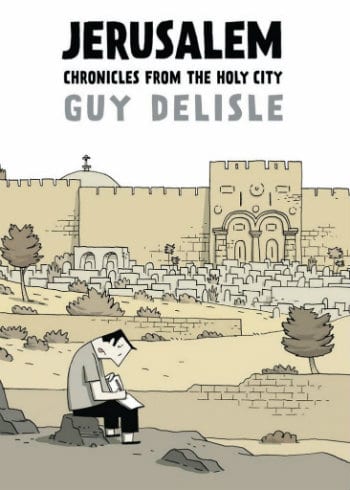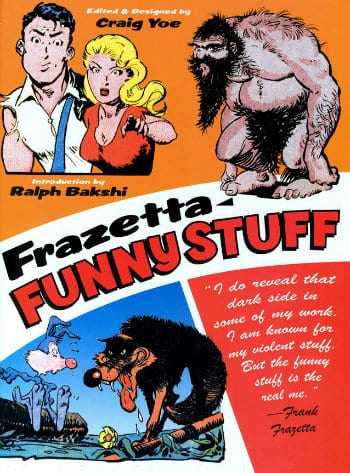Ah, the classic tone-heavy cityscape. Always a key early image in any proper science fiction manga, particularly those released prior to the big boom of the '00s. It always evokes Akira to me, though the legacy of that series remains much diminished. Sure, Katsuhiro Otomo himself has been in the news lately, enjoying a recent solo exhibition and announcing a new ongoing manga series, his first longform comics work in 22 years - he still retains some name recognition, irrelevant as his Western-informed aesthetic might be to legions of younger manga and anime consumers.
But what of the Otomo acolytes? The follow-ups, accidental or otherwise? The manga that found itself licensed in the '90s by virtue of looking 'realistic' and 'detailed' enough to appeal to North American comic book readers? Often they have simply vanished, some of them without ever seeing release outside of the frequently unwieldy comic book miniseries concocted to sell so many hundreds of pages to comic book stores.
Case in point: Chronowar, a 1995 release by writer/artist Kazumasa Takayama that found itself swiftly packaged by Studio Proteus as a nine-issue 1996-97 Dark Horse release. A sequel was produced by the artist in 1999, which was never translated. Indeed, Takayama was never seen in English again, perhaps owing to the comparatively adult nature of his works and the heaviness of his look, redolent with less-than-usually stylized human forms and copious mechanical noodling.
What's interesting about Chronowar, though, is less its art than its concept and structure. The miniseries format plays into this rather nicely, as issue #1 concludes with a big ol' explosion in the city as a plunging satellite crashes down. Beginning with issue #2, the story then backs up and replays the event, isolating three people -- a sad-sack wanted murderer hero; a tough, mean police detective antagonist; and a spirited actress-turned-housewife love interest/idol -- within the grip of a strange robotic alien intelligence, which slows their bodies and perceptions so that they exist outside of the normal stream of time. As a result, the story of Chronowar takes place literally mid-cataclysm, with a giant Otomo-style circular explosion appearing in the background, nearly frozen, as if incorporated into the city's urban design, the work of a populace banking on doom. Certainly it's built into the design of such manga scenarios!
Takayama then builds his book around the exploitation of characters existing in variable states of time, prone to snapping in and out of perception when the ad hoc cyber-gear they've been given lose function, so that a person broken out of the enhanced perception becomes essentially still and floating to other enhanced viewpoints. Above we see one of two major action sequences, a 'slow' set piece in which the befuddled cast attempts to orient themselves to their new reality, gliding through the air at varying velocities, the artist carefully apportioning his use of speed-lined techniques that typically denote what's 'fast' in manga, so that cleanly-drawn 'realistic' depictions become charged with stillness. It's a pretty difficult sensation to convey in words and just a few visual examples, but quite impressive to read over the course of multiple issues - 'action' conveyed in a rigidly formalist manner.
All of that's done toward the beginning of the story. A second, complimentary action set piece occurs near the end, after the characters become used to their abilities and begin to deliberately modulate their movements in and out of varying time speeds to fuck with one another's perceptions, resulting in Takayama drawing blizzards of zooming lines, slowing down just enough to capture moments of violence, such as the pressures of time-shifts causing the character's limbs to tear off of their bodies. It's all part of the alien intelligence's study of inhabited worlds, its own civilization having been wiped out long ago - the cruel detective becomes obsessed with the idea of commanding the intelligence to wipe out humankind's shit legacy and replace it with a perfect machine civilization, prompting our uninspiring hero to 'action,' if only after a huge fit of angst concerning the woman, whom he's utterly loved since she was a talented hopeful in high school, whom he could never get up the nerve to confess to, whom he bought a goodbye gift when she left on a train and thereafter devoted his life to chasing, eventually committing murder in the midst of putting together a movie of his own, no doubt to attract her, but oh woe! She is married to a JERK that WORKS IN AN OFFICE! Whatever happened to his - er, her dreams?
You know this kind of guy. He's a Nice Guy.
I've been trying to watch anime lately. The industry has gotten to the point where an apparatus is in place for television shows to be properly licensed and streamed online with revenues collected through premium memberships and advertisements - I don't know how lucrative it is, but it's easy to access and legal to watch. So I watched the first episode of two new shows by reputable principals -- Kids on the Slope, a classy, '60s-set, josei-inflected youth drama by Cowboy Bebop/Samurai Champloo director Shinichiro Watanabe, and tsuritama, a spastic sports comedy with rad color schemes by Kenji Nakamura, visually resourceful creator of cool shows that never seem to get picked up for English release -- and while I probably shouldn't have selected two shows with similar coming-of-age themes, I was nonetheless startled by how each program seemed to have exactly the same protagonist: a chatty narrator of milquetoast social disposition, anxious and nerdy and just begging for inspiration to shine down on his cloudy world. It's a character type I recognize (with slight variations) from many anime and light novels of the past, ranging from 'quality' productions like Masaaki Yuasa's The Tatami Galaxy to '00s otaku ur-hit The Melancholy of Haruhi Suzumiya.
Chronowar is a seinen manga, ostensibly aimed at older male readers, but the frankness allowed in illustrations like that just above do little to shift the personality of the Hero, the Nice Guy, by which of course I do not mean simply a guy who is nice. I'm talking the stuff of Lars von Trier films and internet flame wars: a dude caught up in the unfairness of his romantic (sexual) life so that it defines his innate, narcissistic self-loathing - the kind of guy who in high school would obsess over how these hot girls would always be going out with JERKS THAT TREAT THEM BAD instead of him, even though he would totally be caring and great, if mainly as a means of setting himself apart as superior to other dudes rather than out of a particularly honest connection with a girl, since in the end all of his interactions with women are primarily a means of bolstering his own tenuous self-esteem, proving himself a worthwhile and successful person by the terms of a society he loathes and yet accepts as the only means of living. A Nice Guy.
Basically, that's the disposition of the hard-luck hero of Chronowar, although he is unfailingly depicted as a romantic cat in a moving drama of love. It is surely the power of love -- you know, the love between some nerd that killed a guy and a woman who hasn't seen him in years and just now realized that the five total sentences she appears to have exchanged with him in high school have been pregnant with the deepest, most broiling affection -- that inspires the woman to do most of the hard work in taking down the nasty detective in speed-shifting combat. Per the terms of male fantasy, our hero does the honors of a sensitive final blow, and later tends to his now-dying beloved, who begs, begs him not to engage in a discreet, non-sexual cloning procedure, I mean like implanting another version of her into her own dying womb.
Obviously, he fucking does it anyway.
Because he's a romantic soul! Because he must give her life! And because, when you think about it, the presence of women in fantasies such as this, Nice Guy fantasies, are at best corollary. Because if these dumb broads had any brains, they'd already be seeing you, eh tiger? No, the triumph of the Nice Guy is the triumph over female agency itself, the definitive validation of the Nice Guy actually knowing what's best for the target of his obsession, and manfully overriding whatever might stand in his way.
The result in Chronowar -- more science fantasy than fiction -- is a lovely nude scene of the growing clone, though make no mistake: we will not sully this romance with the mess of sexual congress! Our Man, humanity saved, returned to normal perception, turns him in to the police for a properly tragic finale. It was his very love (and murdering a guy) that resulted in his (cloned) lover not remembering who he is, while he sits in jail, probably happier in the end to just beat himself up over and over forever.
But... but wait!
Oh man it's that piece of shit earring he bought her in high school! Dear reader, does love spring eternal, even across the ravages of time... the true Chrono-War?? "If only!" exclaims the presumed reader, sighing with eyes raised away from his comic book toward the uncaring heavens beyond his window. "If only!"
***
PLEASE NOTE: What follows is not a series of capsule reviews but an annotated selection of items listed by Diamond Comic Distributors for release to comic book retailers in North America on the particular Wednesday, or, in the event of a holiday or occurrence necessitating the close of UPS in a manner that would impact deliveries, Thursday, identified in the column title above. Not every listed item will necessarily arrive at every comic book retailer, in that some items may be delayed and ordered quantities will vary. I have in all likelihood not read any of the comics listed below, in that they are not yet released as of the writing of this column, nor will I necessarily read or purchase every item identified; THIS WEEK IN COMICS! reflects only what I find to be potentially interesting.
***
SPOTLIGHT PICKS!
Jerusalem: Chronicles from the Holy City: Being the latest release from Guy Delisle, a 2011 record of time spent in the title place, now in English from Drawn and Quarterly. I'm told to expect essentially the same anecdotal-lecture blend as the artist's prior travelogues, but now at 320 pages in length and presumably some especial refinement necessary to emerge as winner of the Fauve d'Or at Angoulême 2012, if such things are indeed necessary. Obviously your lit comics pick from a publisher not somehow involved in the words presently being typed. Preview; $24.95.
Frazetta - Funny Stuff: Might as well counterbalance that with a reprint pick, here the new Craig Yoe production for IDW, a 256-page compilation of early humor and funny animal pieces drawn by Frank Frazetta, along with illustrations created for the text pieces you always skip over in old comics (unless you're me) and some unpublished stuff. Introduction by Ralph Bakshi; $49.99.
--
PLUS!
The Pterodactyl Hunters in the Gilded City: An era winds down as the last few years' worth of Xeric recipients see their comics released, or -- in the case of this November 2010 recipient, created by Brendan Leach -- published by Top Shelf following self-publication as a newspaper broadsheet and a subsequent appearance in The Best American Comics 2011. Lots of praise surrounds this chronicle of balloonist sibling strife and flying lizard hunts in a fantasy 1900s, with notices given by Matt Madden, Tom Hart, Mark Newgarden and this site's Rob Clough. The dimensions are now 11 3/4" x 14 3/8”, and the page count is 44. Preview; $9.95.
I'm not a plastic bag: I also know little about this Archaia hardcover original, save that it's a wordless graphic novel by illustrator Rachel Hope Allison, released in conjunction with various ecological programs for a belated Earth Day experience, and that the publisher is totally going to plant trees in support. I am, however, getting a little bit of a Shaun Tan vibe from its anthropomorphic depiction of a giant island of garbage, based on an actual trash patch somewhere out in the ocean. Preview; $19.95.
Popeye #1 (of 4): A certain writer-on-comics mentioned this to me the other day, expressing some surprise at its quality. It is, of course, only the latest comic book outing for E.C. Segar's creation -- for a while the 1999 Ocean Comics one-off The Wedding of Popeye & Olive was so common it functioned as a sort of Walmart greeter of quarter bins -- here an IDW release with reliable Roger Langridge as writer. The interior artist is one Bruce Ozella, working in a Segaresque style, while Jules Feiffer(!) draws a variant cover. Langridge interview and brief preview; $3.99.
Leviathan: In which Simon & Schuster releases a 112-page North American edition of a 2006 Rebellion collection of a 2003-05 2000 AD feature by writer Ian Edington and artist D'Israeli, concerning a 1920s cruise liner stuck in a netherworld. I tend to like D'Israeli's stuff, and its nice to see one of the shorter serials getting attention in the S&S program. Bart Croonenborghs review/image samples; $16.99.
Black Orchid: Aw, I've got a soft spot for this one, a 1988-89 DC miniseries that introduced writer Neil Gaiman and artist Dave McKean to North American readers. On some days it's actually my favorite of Gaiman's comics, although it's quite far from his 'best' (which would be the 1995 McKean collaboration Mr. Punch) - I would rate it as a failed experiment, but a genuinely ambitious one, seeking to pit the vogue for 'realistic' superheroes then-prevalent against a continuation of Alan Moore's themes from The Saga of the Swamp Thing, a critical early influence on Gaiman, which he undoubtedly read closely and carefully. The result is an extra-normal vegetative superheroine who seeks to oppose not only the evil of a violent superhero world, but the very idea of placing 'good' and 'evil' into Manichean conflict in superheroic narratives. However, it remains very much a superheroic narrative, culminating in a sort of fiat victory that registers as unsatisfying without being insightful - maybe the very first in a line of abrupt Gaiman endings. Still, I appreciate the texture of the effort, now back in print as a Vertigo hardcover; $24.99.
Crossed: Badlands #4: In case anyone was piqued by last week's column, do note that this Avatar horror series is continuing on its biweekly schedule, although the writing for the next six issues will be handled by another Vertigo founding talent/Alan Moore devotee: Jamie Delano, whose done a number of oddball projects with Avatar over the last few years, including the memorably trashy, purplish pirate series Rawbone. The artist is now Leandro Rizzo, replacing Jacen Burrows until issue #10 and the arrival of (third) writer David Lapham; $3.99.
The Secret History #18 (&) #19: Your genre Eurocomic pick(s) are from Archaia, being two issues/albums-in-comic-book-format of this long-running Jean-Pierre Pécau/Igor Kordey-fronted story of immortals dallying with historical occurrences, presently up to t.25 in France. Kordey fans will also note that he presently has an English-language webcomic going, based on an older script by frequent collaborator Darko Macan; $5.95 (each).
CLAMP in Context: A Critical Study of Manga and Anime: Finally, your book-on-comics for the week, a 204-page McFarland release from author Dani Cavallaro, examining the popular manga collective and "[its] broader philosophical underpinnings, its dedication to the invention of elaborate narrative constructs, its legendary passion for multilayered universes, and its symbolic interpretation of human identity." Just to turn this back to anime, CLAMP was recently given free reign of a popular vampire franchise, Blood, and turned out a television series of purportedly Cannibal Holocaust-level misanthropy that didn't so much command my viewership as impress me through is-this-thing-seriously-real review posts such as this. "The candy was made to taste like human organs." Please take that deep into your Tuesday; $35.00.
--
CONFLICT OF INTEREST RESERVOIR: There are a lot of pretty huge Fantagraphics releases this week, including some original sailor man stuff via Popeye Vol. 6 (of 6): Me Li'l Swee'Pea, the final hardcover compilation of Segar's content; $29.99. Then there's Folly: The Consequences of Indiscretion, a 144-page selection of short stories by Hans Rickheit from the pages of Kramers Ergot, various minicomics and other places; $18.99. Then there's Cruisin' with the Hound: The Life and Times of Fred Toote, a 136-page collection of '50s period tales by Spain Rodriguez, seen in Blab! and elsewhere; $19.99. AND THEN there's a new edition of the 1985 Drew & Josh Alan Friedman collection Any Similarity to Persons Living or Dead Is Purely Coincidental, a prime volume in many home libraries; $19.99.
















